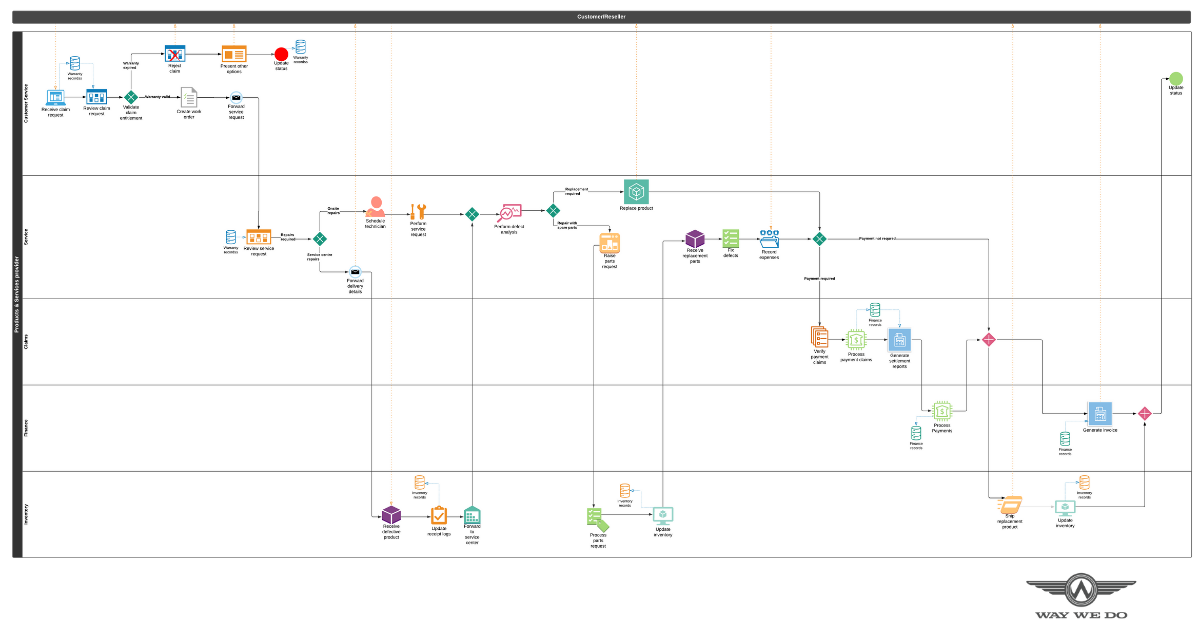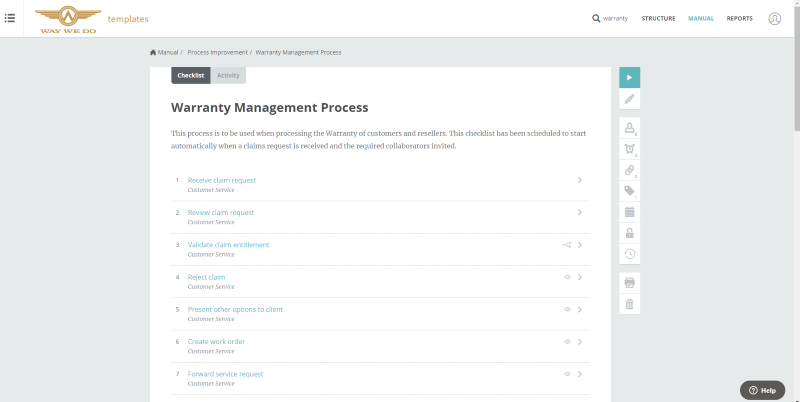Manufacturers and service providers use warranties as a way to give assurance to their customers on the quality of the product or service they’re providing.
Warranty management helps businesses by providing critical information they can use to improve future product and service offerings and so enhance their customer experience.
A well-managed warranty process gives varying degrees of support to the customer and the organization alike. There are numerous reasons business have for wanting to manage their warranty processes better.
1. Improve product management
Unfortunately, most organizations manage their warranties in an ad hoc manner. The result is little to no communication between core business units. Inventory levels and fulfillment times are unclear, as are what products are moving in and out of storage. Warranty management lets you track the flow of physical products from your inventory, and improves communications between sales, logistics and customer service departments.
2. Improve your customer experience levels
Warranties offer more than just how-to instructions to your customers when a product fails. They also give you an avenue to promote other products and services to your customers. And warranty management is more than an efficient way to replace, repair or reimburse customers for a faulty product: It’s also a chance for you to offer after-sales support that can retain customers and attract new ones.
3. Improve product design
The information you collect from warranties can be a catalyst for improved product design and quality. What better way to show your customers how seriously you take their feedback than by manifesting it in design improvements, or even a new version of your product?
4. Better manage distributor (or reseller) relationships
Warranty management helps track transactions and communications between a manufacturer and its distributors. A solid warranty management process can help track and report on things like servicing schedules, invoicing, claims management, performance tracking and quality issues.
5. Manage your reputation
Poor warranty management can negatively impact an organization’s reputation. Remember, warranty management can span several business units. It only takes one of those to drop the ball and the whole brand can be affected. A well-tuned warranty management process shows your commitment to providing a good customer experience. Customers who’ve bought a product from you that has malfunctions and then seen their issue resolved swiftly, smoothly and successfully will be confident to buy from you again, and may even become an ambassador for your brand.
The consequences of poor warranty management
There are costs to maintaining a warranty management system, so it’s important to make sure it’s well run to ensure those costs balance out the benefits. However, having no warranty management system, or one that’s poorly managed, can end up leading to unexpected consequences. It’s important to be aware of the challenges as well as the benefits of having a warranty management system, so both you and your customers will win.
Increased warranty costs
In 2019, Warranty Week published an article about the increasing costs of warranty for US manufacturers between 2003 and 2018. The article stated a rise in warranty costs to $US26.1 billion in 2018, an increase of 5.6% on 2017. There were several reasons attributed to the steady rise, from labor costs associated with warranty administration, to the costs of setting up dedicated claims units. There are also costs associated with poor processes and repairs, all of which offset any revenues generated by offering a warranty.
Fraudulent claims
Poor warranty management raises the risk of warranty fraud – from internal sources, from customers, or from resellers. Warranty fraud can come in a range of forms. For instance, resellers may substitute lower-cost parts when they’re conducting repairs, or they may issue a replacement part. Customers might submit multiple warranty claims for the same service order to receive replacements. Poor internal controls – like incorrect product registrations, manual invoice and claims handling, and poor inventory management – create an ideal environment for warranty fraud.
Data entry errors
A large part of warranty management is administration, particularly inputting and processing data. This is still a manual process for many organizations. It’s time-consuming and prone to inaccuracies and errors. Data entry errors will impact on how well other business units process warranty claims, compromising accuracy and speed when it comes to resolving customers’ issues.
Failure to meet customers’ quality and service expectations
Customers’ expectations are continually changing and increasing. How well you meet these expectations plays a huge role in whether that customer will return, and whether they’ll recommend you to others. If your warranty management system isn’t in sync with the work that’s done, your business units won’t have access to accurate information, leading to miscommunications, frustration, and lost opportunities – not just in sales, but in capturing information that will help you improve your product or service offering and your customer experience.
Responsibilities in the warranty management process
Many organizations typically handle warranties internally within a single business unit. Often, there’ll be no transparency on what work has been done and little information is passed across to other business units. This leads to the types of challenges we explored earlier. A well-managed warranty system should span multiple business units and promotes synergy between them. Each team plays an important part in the warranty management process and every activity in the process can be its own separate sub-process with each unit.

There are seven key functional areas in a Warranty Management Process.
- Product development – typically responsible for the product’s overall design and quality. This area creates the terms and conditions of what are deemed the manufacturer’s obligations and the customer’s obligations on a product warranty. Product development updates content related to the product. It creates the warranty, and assigns asset components or individual parts to associated warranties.
- Customer service – always the first point of contact from the customer’s perspective, whether it’s to file a warranty claim, enquire about warranty terms, or ask about additional products or extended warranty for the products they’ve purchased.
- Resellers – manage supply and recovery on behalf of the manufacturer, and for providing replacements to customers. They’re also responsible for relaying market trends and customer design requests, as well as managing product recalls and so on.
- Service – includes representatives in house and in the field. They’re responsible for executing work orders and making sure customers understand your warranty terms. Service reps also ensure warranty terms are dealt with fairly and aren’t abused by customers. While in-house reps may find it difficult to review defects and oversee repairs, field service reps can visit customer locations to investigate defects, and make sure repairs and replacements comply with warranty terms and conditions.
- Repairs – receives parts and products that have been returned and either repairs them according to warranty terms and conditions, or issues replacements.
- Finance – audits and reviews all warranty claims and processes any claim-related payments to customers and resellers alike.
- Claims – works closely with the Finance team to review and verify warranty claims submitted to the organization.

A streamlined warranty management process gives clear visibility and demarcation of work to each functional unit within your business, and reduces the chance of error and rework. It also creates the opportunity to integrate the different systems that process warranty records at their varying stages. One way to achieve this is by using Way We Do’s Activated Checklists and the Way We Do connectors on Microsoft Power Automate (formerly Flow) and Zapier.
Supporting service agents and resellers
A well-managed and easy to use warranty management process also provides a clear support channel for your associated service agents and resellers. This not only makes it easier for them to do business with you, but also makes it easier for them to serve their customers (reflecting well on your brand in turn). Here are some suggestions for how to support your agents, and therefore your customers.
- Reduce manual interventions. Eliminate redundant data entry by investing in a system that can serve as a database for capturing warranty information for both customers and resellers. This can also help reduce human errors and warranty fraud from claims failing through the cracks. The system also doubles as an information database that holds customer information relating to services, updates, and case notes.
- Provide real-time access to product warranty information. Having this vital information handy helps you make sure you’re giving your customers the right services at the right time. It also keeps your resellers up-to-date on key data, like inventory levels, and claims and payments processing.
- Identify key metrics for improvement and customer satisfaction. You can use the information you collect from managing warranties to identify key metrics like claims frequency, suppliers’ performance, warranty costs as a percentage of sales, and so on. Analyzing these results can help you more effectively manage your warranty and claims process, leading to costs savings, increased customer satisfaction, even product and service improvements – all of which you can transform into a competitive advantage for your business.
- Use technology and process automations. A key challenge in effective warranty management is the errors that result from manual data processing, and manual handovers between business units. Business technologies provide numerous opportunities to better integrate workflows between units and are ideal for managing warranty processes: Customer relationship management systems gather customer data and case notes; process management systems (like Way We Do) manage tasks, workflows, and process handovers; enterprise systems manage stock movements, procurement and shipping. Integrating your different business systems can eliminate the need for manual entry, reducing admin costs, and the risk of errors.
Is it time you created (or updated) your own warranty management system?
If you’ve ever thought about offering warranties but have shied away from the prospect of all the extra administration, Way We Do can help. Reach out to the team to explore what’s involved and how to make this process work for you.





